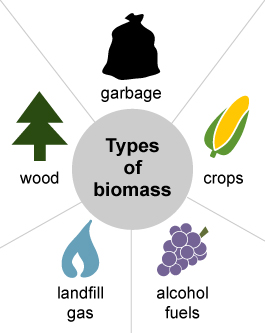Biomass
Biomass is any organic material, derived from plants or animals, that can be burned to produce harnessable energy. Often biomass is converted into a liquid (liquid biofuels, like ethanol and biodiesel) or gas (biogas). Solid biomass includes woody plant matter and municipal solid waste (garbage). Liquid biofuels are produced from agriculture, and biogas is usually captured from the decomposition of solid biomass in landfills or sites with animal manure.

Photo:U.S. Energy Information Administration
Municipal Solid Waste (MSW), or garbage, is a surprisingly principal source of biomass. Waste-to-energy plants, located at landfills, either burn MSW directly or utilize biogas, which is a product of MSW.
Unlike other renewables, biomass is not emissions-free. A product of biomass combustion is carbon dioxide, a greenhouse gas and the main culprit behind climate change. Furthermore, waste-to-energy plants can pollute dangerous gases and ash laced with toxic heavy metals and therefore face stringent oversight from the federal Environmental Protection Agency. Despite these concerns, landfill gas and waste-to-energy treatments are palatable options to begin replacing nonrenewable fossil fuels, since landfills will be filled independently of the energy portfolio. In Rhode Island, biomass is currently the largest piece of the renewable pie, though renewables account for a diminutive fraction of the state’s energy. Biomass accounted for 4% of Rhode Island electricity production in 2017. A 30 megawatt landfill in Johnston was the largest onshore renewable power plant. Biomass is an important component of Rhode Island’s current energy plan, but the development of emissions-free renewables is the necessary next step in Rhode Island’s energy future.
Sources:
https://www.eia.gov/energyexplained/index.php?page=biomass_home
https://www.eia.gov/state/analysis.php?sid=RI

















